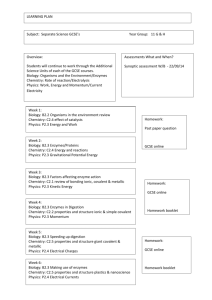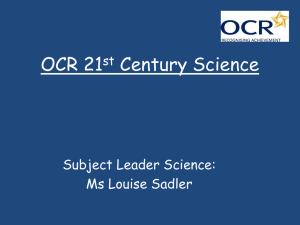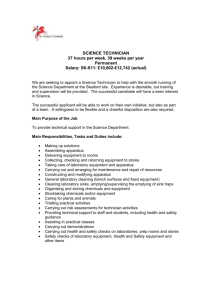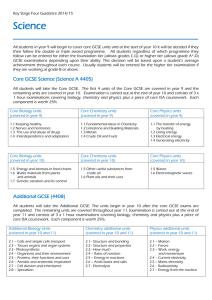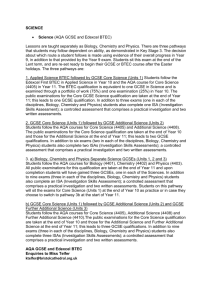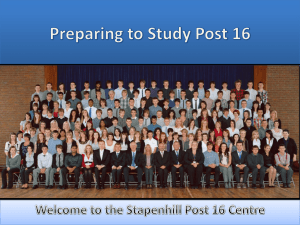Science KS4 Curriculum
advertisement
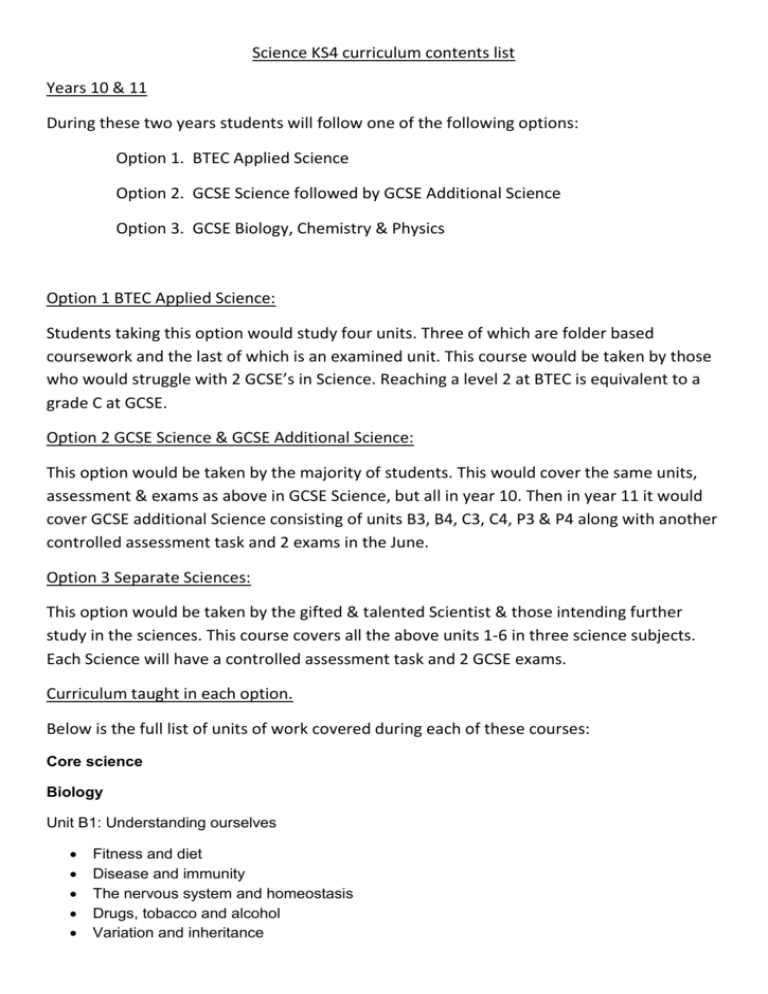
Science KS4 curriculum contents list Years 10 & 11 During these two years students will follow one of the following options: Option 1. BTEC Applied Science Option 2. GCSE Science followed by GCSE Additional Science Option 3. GCSE Biology, Chemistry & Physics Option 1 BTEC Applied Science: Students taking this option would study four units. Three of which are folder based coursework and the last of which is an examined unit. This course would be taken by those who would struggle with 2 GCSE’s in Science. Reaching a level 2 at BTEC is equivalent to a grade C at GCSE. Option 2 GCSE Science & GCSE Additional Science: This option would be taken by the majority of students. This would cover the same units, assessment & exams as above in GCSE Science, but all in year 10. Then in year 11 it would cover GCSE additional Science consisting of units B3, B4, C3, C4, P3 & P4 along with another controlled assessment task and 2 exams in the June. Option 3 Separate Sciences: This option would be taken by the gifted & talented Scientist & those intending further study in the sciences. This course covers all the above units 1-6 in three science subjects. Each Science will have a controlled assessment task and 2 GCSE exams. Curriculum taught in each option. Below is the full list of units of work covered during each of these courses: Core science Biology Unit B1: Understanding ourselves Fitness and diet Disease and immunity The nervous system and homeostasis Drugs, tobacco and alcohol Variation and inheritance Plant growth Unit B2: Understanding our environment Classification and food chains Carbon and nitrogen cycle Competition, interdependence and adaptations Evolution Pollution and sustainability Chemistry Unit C1: Carbon Chemistry Crude oil and hydrocarbons Carbon fuels and air pollution Alkanes, alkenes and polymers Cooking and food additives Smells, nail varnish and testing Paints and pigments Unit C2: Chemical resources Structure of the Earth and plate tectonics Construction materials and concrete Copper, alloys and corrosion Making ammonia Acids and alkalis and making fertilisers Chemicals from salt and electrolysis Physics Unit P1: Energy for the home Heat and temperature Conduction, convection and radiation Insulation and energy efficiency Electromagnetic spectrum Analogue and digital Seismic waves Unit P2: Living for the future Generating electricity Global warming Power Fossil fuels and biomass Radiation Solar system Additional Science Biology Unit B3: Living and growing DNA and genes Proteins and enzymes Respiration and exercise Mitosis and meiosis Circulatory system Selective breeding Genetic engineering and cloning Unit B4: It’s a green world Identification keys Photosynthesis and the leaf Plant structure Transpiration Plant minerals Decay and recycling Intensive and organic farming Chemistry Unit C3: Chemical economics Rates of reaction Relative formula mass Conservation of mass Percentage yield Energy and reactions Nanochemistry Unit C4: The periodic table Atomic structure, Ionic and covalent bonding Group 1 and 7 elements Transition elements Metallic structure Superconductors Purifying water Physics Unit P3: Forces and motion Speed and stopping distances Work and power Kinetic energy Momentum Collisions and car safety Gravitational potential energy Unit P4: Electricity, waves and radiation Electrostatics Current and resistance Longitudinal waves and ultrasound Radioactivity and uses of radiation Nuclear power Chain reactions and nuclear fusion Units for separate sciences only Biology Unit B5: The living body Skeletons, muscles and joints Circulatory and respiratory systems Digestive and excretory systems Reproductive system Growth Transplants Unit B6: Beyond the microscope Bacteria, fungi and viruses Transmission and development of disease Useful bacteria and brewing Biofuels Life in soil and water Enzymes Genetic engineering DNA fingerprinting Chemistry Unit C5: Quantitative analysis Moles and molar mass Percentage composition and empirical formulae Concentration and dilution pH curves and titrations Equilibria Making sulphuric acid Making insoluble compounds Testing ions Unit C6: Chemistry out there Electrolysis of solutions Fuel cells Redox reactions and rusting Fermentation and alcohols The ozone layer Water hardness Emulsions, soap and detergents Physics Unit P5: Space for reflection Satellites Equations of motion Projectiles Momentum changes Waves through the atmosphere The ionosphere and diffraction Light, refraction and dispersion Lenses and lens diagrams Unit P6: Electricity for gadgets Resistance, voltage and current Potential divider LDRs, thermistors and resistors Logic gates Dynamo effect Transformers and their uses Diodes and capacitors This is an overview of the course for each year. Further details are included in the Scheme of Work for this subject. If you wish a copy of the scheme of work you should contact the school office. If it is a printed document we will have to make a small photocopying charge, in accordance with school policies. Please note the Scheme of Work is a working document which changes as the year progresses.


